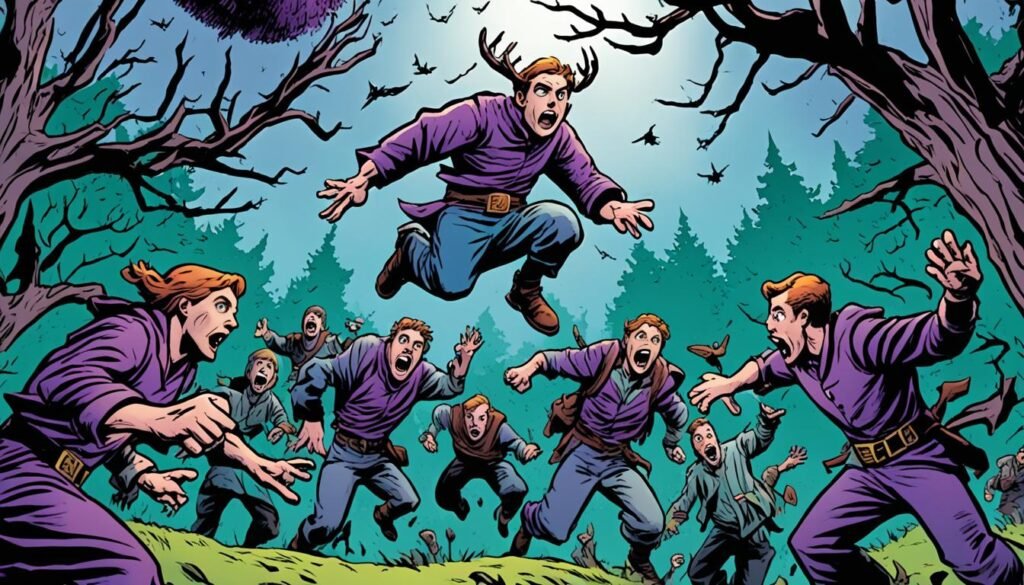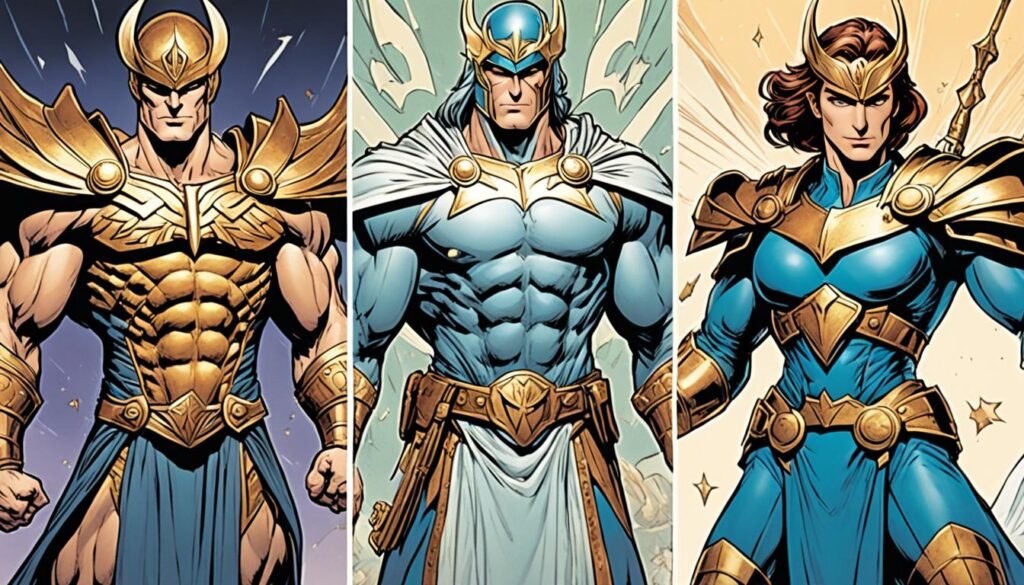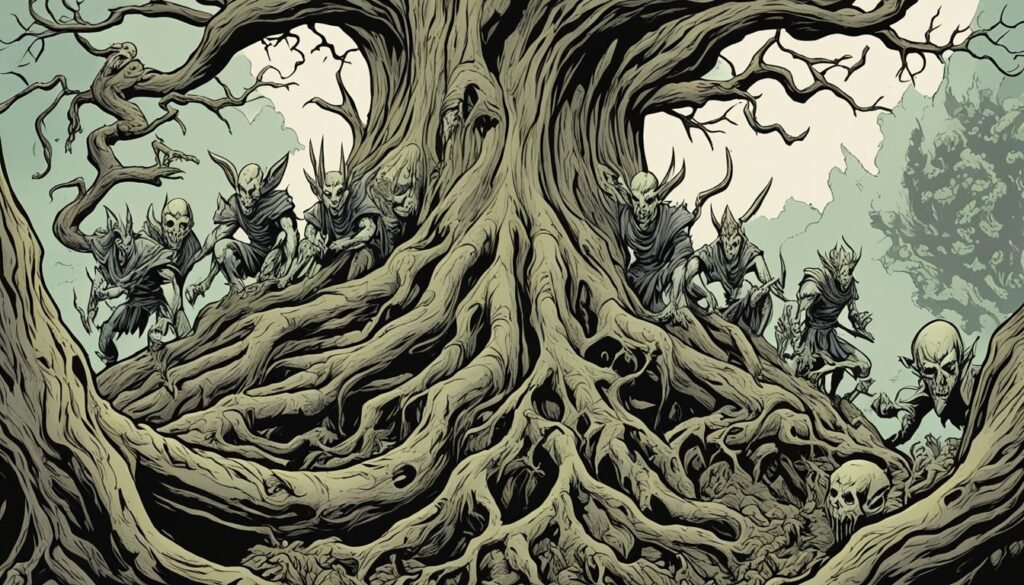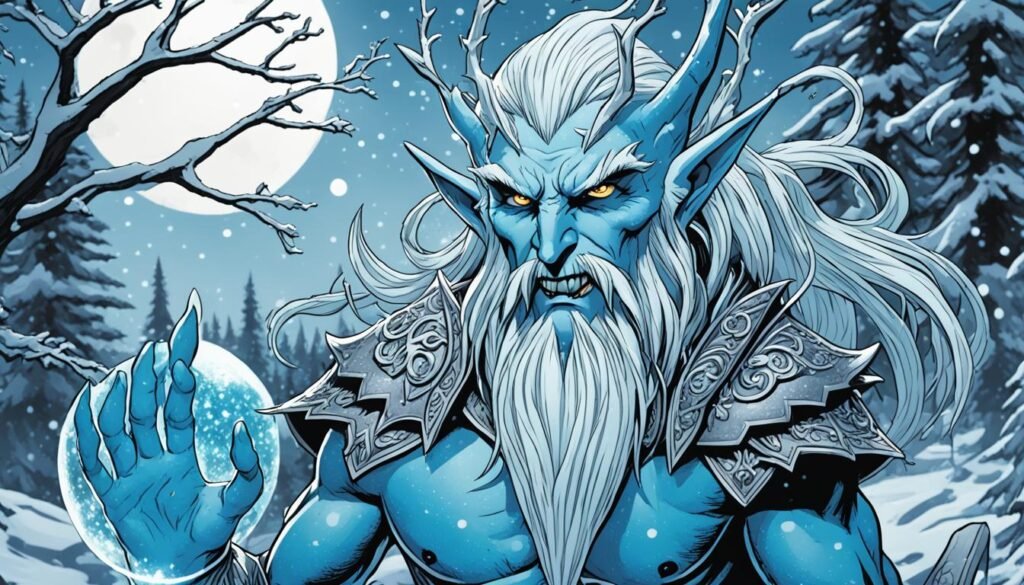In the heart of the Philippine archipelago, ancient beliefs mix with daily life. A captivating story of the Dalaketnons captures the Filipino people’s imagination. These Dalaketnons, known as the “evil engkanto,” live in the Dalakit or Balete trees. Their existence both fascinates and frightens locals.
On a moonlit night in a village surrounded by lush hills, Maria was drawn to a large, ancient Balete tree. Its roots and leaves enchanted her. She saw a tall, handsome man who glowed in the moonlight. Maria was mesmerized, not knowing he was a Dalaketnon>, one of the elf-like beings in Philippine mythology.
The Dalaketnons are described as handsome and beautiful. They look like high nobles from ancient Philippines. Males have light-colored skin and very dark hair, while females have bronze-brown skin and brown hair. A unique feature of theirs, according to folklore, is leaf-shaped, pointy ears. This trait enhances their elf-like look.
Key Takeaways
- The Dalaketnons are a race of elf-like beings in Philippine mythology, known as “evil engkanto”.
- They are said to reside in Dalakit or Balete trees and are often described as handsome and beautiful.
- Dalaketnons exhibit sexual dimorphism, with distinct physical traits between males and females.
- They are portrayed as having leaf-shaped, pointy ears, further contributing to their elf-like appearance.
- The Dalaketnons and their narratives are deeply rooted in the rich tapestry of Philippine folklore and mythology.
Introduction to the Dalaketnon
The Dalaketnons are a special group in Philippine mythology. They are called “Dalaketnon” which means “from the Dalakit tree.” This is because they were believed to live in Dalakit trees in Visayan culture.
Origins of the Dalaketnon in Philippine Folklore
Legend says the Dalaketnons had leaf-shaped, pointy ears. Today, we imagine them as tall, handsome males and beautiful females. They wear clothes like the noble people of the principalía did in the old Spanish-occupied Philippines.
Defining Characteristics and Physical Traits
The Dalaketnons are a type of Engkanto in Philippine folklore. Engkanto are mystical beings of the land, admired for their looks and sweet scent. Dalaketnons, elf-like beings like Tamawo and Wenri-Wenri, also belong in the Engkanto family.
Dalaketnon and Their Relation to Other Engkanto Beings
The Dalaketnons are a type of Engkanto in Philippine folklore. Engkanto are beings of the earth known for their beauty and scent. Like Tamawo and Wenri-Wenri, Dalaketnons fit under the Engkanto group too.
The Dalaketnon and Their Malevolent Nature
In Philippine mythology and folklore stories, the Dalaketnons stand out as grim characters. They’re famous for drawing in and snatching away innocent people. These victims end up in another world, invited to luxurious feasts. Here, they are forced to eat black rice. This meal puts them in a spell, making them the Dalaketnons’ prisoners.
Accounts of Abduction and Trickery
Stories tell of the Dalaketnons’ skills in trickery and abduction. With their captivating looks and charisma, they tempt humans into joining their extraordinary celebrations. Once someone is hooked, escape seems impossible. They’re left forever in the realm of the Dalaketnons.
Dalaketnon as Rulers of Evil Engkanto
Dalaketnons are said to come from a high-ranking evil engkanto family. In Philippine mythology, they are seen as top leaders. They command a range of wicked creatures, including Tiyanak, Aswang, and Manananggal.

Dalaketnon: The Evil Engkanto Elf-Like Beings
The Dalaketnon are a group of elf-like beings from Philippine mythology. They are known as evil engkanto. These supernatural creatures live in Dalakit or Balete trees.
They look striking and wear clothes like ancient Filipino nobles. This makes them stand out in stories.
They have amazing powers, like moving things without touching them and making more of themselves. Folklore says they can kidnap people. They take them to another space and make them eat black rice. This black rice makes people do what the Dalaketnons want. They are leaders of other scary creatures, like Tiyanak and Aswang. This makes them seem even more evil in tales.
The stories about the Dalaketnons are many and often scary. They are known to change people into beings like them. This is done using their special black rice. Their presence is always captivating in Philippine mythology. People, both in the Philippines and around the world, still find their stories interesting. This keeps the Dalaketnons’ legend alive and well in Philippine folklore.
Sexual Dimorphism in Dalaketnon
In the world of Philippine mythology, there are the Dalaketnons. They are known for their special trait of sexual dimorphism. This means the male and female Dalaketnons look very different from each other.
Male Dalaketnons stand out with their very fair skin and extremely dark hair. Meanwhile, female Dalaketnons have bronze-brown skin and dark brown hair. This unique difference makes the Dalaketnon species easily recognizable.
Physical Differences Between Male and Female Dalaketnon
The visual differences in the Dalaketnons go beyond just their looks. Legend whispers that these beings have leaf-shaped, pointy ears. They can also change their hair and eyes to white while using powers like telekinesis and creating copies of themselves.
Symbolism and Significance of Sexual Dimorphism
The stark contrast in looks for male and female Dalaketnons could mean more than just appearance. Within Philippine stories, this could mean something important, be it about culture or spirituality. These unique traits add to the allure and mystery of the Dalaketnons, captivating those who delve into their myths.

Dalaketnon and the Balete Tree
The Dalaketnons are said to live in special trees, called Dalakit or Balete. These Balete trees have deep meaning in the Philippines. They’re linked to the world of myths and spirits.
Significance of the Balete Tree in Philippine Folklore
In Philippine folklore, the Balete tree is very special. It’s thought of as a door to a different, mystical world. Here, Engkanto beings, like the Dalaketnons, might dwell. Its size and roots add to its magical reputation.
Dalaketnon’s Connection to the Balete Tree
The Dalaketnons have a close tie to the Balete tree. This link is part of their name too. It shows how important these elf-like creatures are in Philippine folklore.
The Balete tree is more than just a home for the Dalaketnons. It helps us know more about the malevolent Engkanto beings in Philippine beliefs. The tree is key to understanding their culture and myths.
Dalaketnon and the Black Rice Myth
In the stories of Dalaketnon, special rice is given to people who are taken away. This rice is black or violet. Eating this black rice is seen as agreeing to get married to a Dalaketnon. It makes the stories more mysterious and interesting.
The black or violet rice in Philippine folklore is very special. When someone eats this rice, they are linked to the world of the Dalaketnons. This shows that the stories have deep mystical and spiritual undertones.
Contemporary Depictions of Dalaketnon
In modern media and literature, Dalaketnons stand out. They’re often shown as beautiful, pale beings. They wear rich clothes that remind us of the noble class in the Spanish-era Philippines. These Dalaketnon figures are known for throwing big, fancy meals. At these events, they invite people to join, luring them in with their charm.
Dalaketnon in Modern Media and Literature
The Dalaketnon are a hit in today’s modern media and literature in the Philippines. Their alluring looks and magical ways have captured many hearts. The depictions of these elf-like beings are inspired by old Philippine folklore. They mix mystique with the elegance of ancient noble families.
Evolution of Dalaketnon Narratives Over Time
The stories about Dalaketnon have changed through the years. This shows how dynamic Philippine mythology is. Over time, Dalaketnon traits have mixed with other Engkanto features. For example, the Tamawo. This mix highlights the ongoing crafting and reimagining of these mythical beings as each era passes.

Dalaketnon and Their Relationship with Humans
Dalaketnons are like elves in Philippine folklore. They are known to interact with humans. Many believe that these beings are actually evil spirits known as engkanto. Stories about Dalaketnons include many tales of how they live and interact with people.
Tales of Interaction and Coexistence
The folklore about Dalaketnons tells of their interactions with people. They show that these beings can live among humans without being recognized. They share beautiful stories of how Dalaketnons tempt people with their looks and huge feasts.
Interpretations of Dalaketnon Stories
The stories of Dalaketnons offer deep insights. They help us understand the rich culture and beliefs of the Philippines. This includes the symbolism of the supernatural in Philippine folklore.
Regional Variations of Dalaketnon Lore
The Dalaketnon, among other Engkanto beings, are found all over the Philippines. Yet, their stories and features vary from region to region. Understanding these differences helps us see how culture and local beliefs shape their myths.
Similarities and Differences Across Regions
The Dalaketnon myths share a common base across the Philippines. Still, each area might tell the stories a bit differently. For example, one place might highlight their special dress and elegant appearance. Another might talk more about their strange, sometimes harmful, interactions with humans.
Cultural Influences on Dalaketnon Narratives
Given these regional differences, it’s clear that Dalaketnon tales are shaped by local culture, history, and geography. This shows the richness and variety of Philippine folklore. It evolves to reflect the unique customs and views of different communities.

Dalaketnon and Their Place in Philippine Mythology
The Dalaketnons are key in Engkanto mythos, shaping Philippine folklore and culture. Stories about them highlight the depth of native tales and the lasting power of the supernatural in the Philippines.
Significance of Dalaketnon in Philippine Culture
The Dalaketnons are at the heart of the Philippines’ spiritual and cultural essence. Known as elf-like beings, they are both revered and feared. Their folk tales deeply interest people everywhere, showcasing the wide range of the country’s folklore.
Dalaketnon’s Enduring Legacy and Impact
The Dalaketnon and other mythical beings still capture our imagination. They are featured in stories, books, and movies, highlighting their ongoing influence in Philippine mythology. Their legacy proves the depth and variety of the country’s ancient beliefs.
Conclusion
The Dalaketnons are a unique group of Engkanto in Philippine folklore and mythology. They have drawn interest from people worldwide. These creatures, resembling elves, are tied to the Balete tree. This link shows how indigenous beliefs and the supernatural continue to shape the Philippines’ culture.
The stories about Dalaketnons reveal the diverse nature of Philippine folklore. Their unique features, magical activities, and interactions with people provide deep insights. These insights show the varied views of these mythical beings. The differences in their tales also highlight how the Philippines’ regions have influenced them.
The Philippines is working hard to keep its rich mythical and folklore heritage alive. The Dalaketnons play a big role in this effort. They represent the ongoing impact these supernatural beings have on the country’s culture and creativity. Learning about the Dalaketnons and other mythical creatures enriches our knowledge. We gain a better understanding of the country’s unique and diverse culture.

